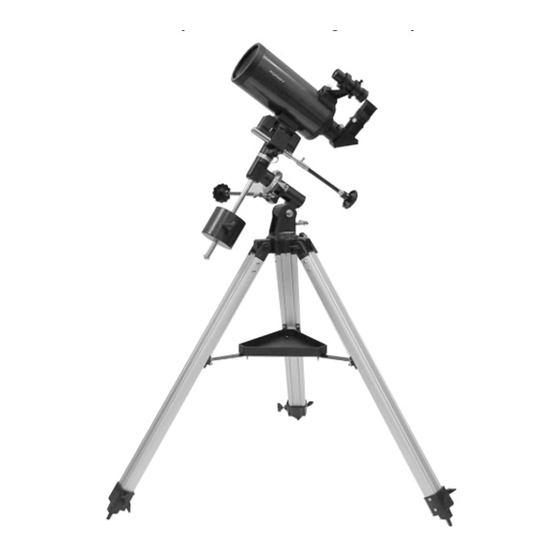Table of Contents
Advertisement
Quick Links
Advertisement
Table of Contents

Summary of Contents for ORION TELESCOPES & BINOCULARS StarMax 90 EQ 9821
- Page 1 INSTRUCTION MANUAL Orion ® StarMax 90 EQ ™ #9821 Equatorial Maksutov-Cassegrain Telescope Customer Support (800) 676-1343 E-mail: support@telescope.com Corporate Offices (831) 763-7000 P.O. Box 1815, Santa Cruz, CA 95061 Providing Exceptional Consumer Optical Products Since 1975 IN 162 Rev. B 03/02...
- Page 2 Finder scope bracket Finder scope Mounting block Eyepiece Counterweight shaft Star diagonal Right Ascension slow-motion control Declination slow motion control Counterweight Counterweight lock knob Tripod leg Accessory tray Accessory tray bracket Leg lock knob Figure 1. Orion StarMax 90mm EQ...
-
Page 3: Table Of Contents
Welcome to a new world of adventure. Your new StarMax 90mm EQ is designed for high-resolution observing of astronomical objects, and can also be used for terrestrial exploration. With its precision optics and equatorial mount, you’ll be able to locate and enjoy hundreds of fascinating celestial objects, including the planets, Moon, and a variety of deep-sky galaxies, nebulas, and star clusters. -
Page 4: Assembly
Soft carry case enough to connect each end of the accessory tray brack- et to the attachment point on each leg. Use the screw and Assembly tools (small wrench, Phillips head lock nut that come installed in each attachment point to screwdriver, triangular assembly tool) do this. -
Page 5: Getting Started
latitude lock t-bolt. The declination (Dec.) and right ascen- 15. Now, insert the chrome barrel of the 25mm eyepiece into sion (R.A.) axes may need re-positioning (rotation) as the star diagonal. Secure the eyepiece with the thumb- well. Be sure to loosen the R.A. and Dec. lock knobs screws on the star diagonal. -
Page 6: Setting Up And Using The Equatorial Mount
remains horizontal even when you let go of the telescope with Nylon thumbscrew both hands (Figure 3b). 3. Retighten the counterweight lock knob. O-Ring The telescope is now balanced on the R.A. axis. It is not nec- (not shown) essary to balance the telescope on the Dec. axis, since the optical tube’s mounting block is positioned so that the tele- Rubber scope will automatically be balanced on that axis. - Page 7 keeping them from drifting out of the telescope’s field of view 3. Loosen the Dec. lock knob and rotate the telescope opti- while you’re observing. cal tube until it is parallel with the R.A. axis, as it is in Figure 1. The pointer on the Dec. setting circle should This is accomplished by slowly rotating the telescope on its read 90°.
- Page 8 motion control cable is not needed for tracking. Objects will Center the star in the telescope’s field of view with the appear to move faster at higher magnifications, because slow-motion control cables. the field of view is narrower. 4. Rotate the setting circle until the metal arrow indicates Optional Motor Drives for Automatic Tracking the R.A.
-
Page 9: Using Your Telescope-Astronomical Observing
What if you need to aim the telescope directly north, but at 6. Using Your Telescope— an object that is nearer to the horizon than Polaris? You Astronomical Observing can’t do it with the counterweight down as pictured in Figure 1. Again, you have to rotate the scope in R.A. so the Choosing an Observing Site counterweight shaft is positioned horizontally. - Page 10 dark-adapted, more stars will glimmer into view and you’ll be are quite small, yet are somewhat bright, so higher power able to see fainter details in objects you view in your telescope. may show more detail. To see what you’re doing in the darkness, use a red-filtered The best rule of thumb with eyepiece selection is to start with flashlight rather than a white light.
- Page 11 C. The Planets smudges. Our eyes are not sensitive enough to see color in deep-sky objects except in a few of the brightest ones. But as The planets don’t stay put like the stars, so to find them you you become more experienced and your observing skills get should refer to Sky Calendar at our website (www.tele- sharper, you will be able to ferret out more and more subtle scope.com), or to charts published monthly in Astronomy,...
-
Page 12: Terrestrial Viewing
Messier objects, first catalogued about 200 years ago by the the finder scope is covered with foil or some other completely French astronomer Charles Messier, which represent some opaque material. of the best and brightest deep-sky objects. 8. Photography Determine in which constellation the object lies. Now, find the constellation in the sky. -
Page 13: Specifications
adapter. Also keep the finder scope caps on if you leave it 10. Specifications attached to the optical tube. Optical design: Maksutov-Cassegrain Cleaning the Tube Aperture: 90mm Your StarMax 90mm EQ telescope requires very little Effective focal length: 1250mm mechanical maintenance. The optical tube is aluminum and has a smooth painted finish that is fairly scratch-resistant. - Page 16 One-Year Limited Warranty This Orion StarMax 90mm EQ ™ is warranted against defects in materials or workmanship for a period of one year from the date of purchase. This warranty is for the benefit of the original retail purchaser only. During this warranty period Orion Telescopes & Binoculars will repair or replace, at Orion’s option, any warranted instrument that proves to be defective, provided it is returned postage paid to: Orion Warranty Repair, 89 Hangar Way, Watsonville, CA 95076.

















Need help?
Do you have a question about the StarMax 90 EQ 9821 and is the answer not in the manual?
Questions and answers